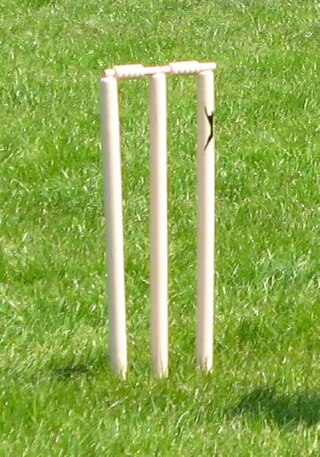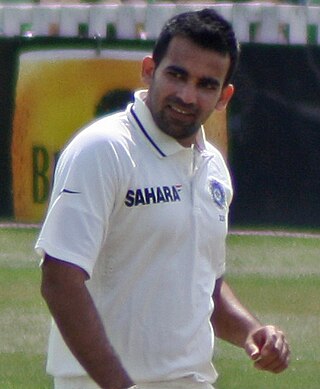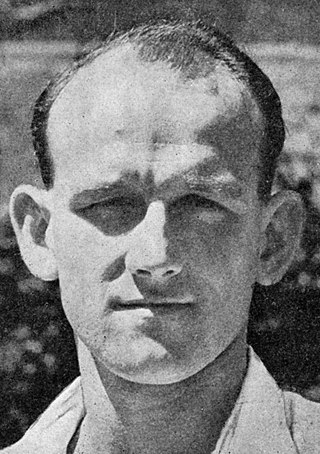Related Research Articles

Bowling, in cricket, is the action of propelling the ball toward the wicket defended by a batter. A player skilled at bowling is called a bowler; a bowler who is also a competent batter is known as an all-rounder. Bowling the ball is distinguished from throwing the ball by a strictly specified biomechanical definition, which restricts the angle of extension of the elbow. A single act of bowling the ball towards the batsman is called a ball or a delivery. Bowlers bowl deliveries in sets of six, called an over. Once a bowler has bowled an over, a teammate will bowl an over from the other end of the pitch. The Laws of Cricket govern how a ball must be bowled. If a ball is bowled illegally, an umpire will rule it a no-ball. If a ball is bowled too wide of the striker for the batsman to be able to play at it with a proper cricket shot, the bowler's end umpire will rule it a wide.

Backyard cricket, also known as Bat ball, street cricket, beach cricket, corridor cricket, garden cricket, and box cricket, is colloquially referred to as gully cricket in the Indian subcontinent. This informal variant of cricket is an universally inclusive game, welcoming all genders and ages. It is typically played in various non-traditional venues such as gardens, backyards, streets, parks, carparks, beaches, and any area not specifically designed for the sport.

In cricket, the term wicket has several meanings:

This is a general glossary of the terminology used in the sport of cricket. Where words in a sentence are also defined elsewhere in this article, they appear in italics. Certain aspects of cricket terminology are explained in more detail in cricket statistics and the naming of fielding positions is explained at fielding (cricket).

Wasim Akram HI is a Pakistani cricket commentator, coach, and former cricketer and captain of the Pakistan national cricket team. Akram is regarded as one of the greatest fast bowlers of all time, as well as one of the greatest left-arm fast bowlers in cricket history. He is often revered as The Sultan of Swing . In October 2013, Wasim Akram was the only Pakistani cricketer to be named in an all-time Test World XI to mark the 150th anniversary of Wisden Cricketers' Almanack. As captain, he led Pakistan to the finals of the 1999 Cricket World Cup, where they lost to Australia by 8 wickets.
Fast bowling is one of two main approaches to bowling in the sport of cricket, the other being spin bowling. Practitioners of pace bowling are usually known as fast bowlers, quicks, or pacers. They can also be referred to as a seam bowler, a swing bowler or a fast bowler who can swing it to reflect the predominant characteristic of their deliveries. Strictly speaking, a pure swing bowler does not need to have a high degree of pace, though dedicated medium-pace swing bowlers are rarely seen at Test level in modern times.
Swing bowling is a technique used for bowling in the sport of cricket. Practitioners are known as swing bowlers. Swing bowling is generally classed as a subtype of fast bowling.

Zaheer Khan is an Indian former professional cricketer who played all forms of the game for the Indian national team from 2000 till 2014. He is a fast-medium left-arm bowler. He was the second-most successful Indian pace bowler in Test cricket, behind Kapil Dev. Zaheer Khan started his domestic career by playing for Baroda. In the early years of his career, Zaheer Khan was known for his hostile seam and pace bowling, especially fast inch-perfect yorkers. He is often considered one of the best Indian fast bowlers.

Spin bowling is a bowling technique in cricket, in which the ball is delivered slowly but with the potential to deviate sharply after bouncing. The bowler is referred to as a spinner.
An outswinger is a type of delivery of the ball in the sport of cricket. In such a delivery the ball curves—or "swings"—out and away from the batter's body and the wicket. By contrast, an inswinger swings in toward the batter and the wicket. Outswingers are bowled by swing bowlers.
An inswinger is a type of delivery of the ball in the sport of cricket. In such a delivery the ball curves—or "swings"—in toward the batter's body and the wicket. By contrast, an outswinger swings away from the line of the batter and the wicket. Inswingers are bowled by swing bowlers.

Waqar Younis Maitla HI is a Pakistani cricket coach, commentator and former cricketer who captained Pakistan national cricket team. A right-arm fast bowler, he is regarded as one of the greatest bowlers in cricket. He is the former head coach of the Pakistani cricket team.

Cricket clothing and equipment is regulated by the laws of cricket. Cricket whites, sometimes called flannels, are loose-fitting clothes that are worn while playing cricket so as not to restrict the player's movement. Use of protective equipment, such as cricket helmets, gloves and pads, is also regulated.

Sydney Francis Barnes was an English professional cricketer who is regarded as one of the greatest bowlers of all time. He was right-handed and bowled at a pace that varied from medium to fast-medium with the ability to make the ball both swing and break from off or leg. In Test cricket, Barnes played for England in 27 matches from 1901 to 1914, taking 189 wickets at 16.43, one of the lowest Test bowling averages ever achieved. In 1911–12, he helped England to win the Ashes when he took 34 wickets in the series against Australia. In 1913–14, his final Test series, he took a world record 49 wickets in a Test series, against South Africa.

A delivery or ball in cricket is a single action of bowling a cricket ball toward the batter. Once the ball has been delivered, batters may attempt to score runs, with the bowler and other fielders attempting to stop this by getting the batters out. When the ball becomes dead, the next delivery can begin.

Frank Holmes Tyson was an England international cricketer of the 1950s, who also worked as a schoolmaster, journalist, cricket coach and cricket commentator after emigrating to Australia in 1960. Nicknamed "Typhoon Tyson" by the press, he was regarded by many commentators as one of the fastest bowlers ever seen in cricket and took 76 wickets at an average of 18.56 in 17 Test matches.
Sarfraz Nawaz Malik is a former Pakistani Test cricketer and politician, who was instrumental in Pakistan's first Test series victories over India and England. Between 1969 and 1984, he played 55 Tests and 45 One Day Internationals and took 177 Test wickets at an average of 32.75. He is known as one of the earliest exponents of reverse swing.
The English cricket team in Australia in 1946–47 was captained by Wally Hammond, with Norman Yardley as his vice-captain and Bill Edrich as the senior professional. It played as England in the 1946–47 Ashes series against the Australians and as the MCC in their other matches on the tour. They were regarded as a sound team which was just as strong as Australia, but due to the Second World War they were an ageing side and their bowling depended heavily on Alec Bedser and Doug Wright, who were overused and exhausted as a result. Australia beat England 3-0 in a five-match series to retain the Ashes; England suffered the worst defeat in a Test series since losing 4–1 to Australia in 1924–25. Since 1881, Tests in Australia were played to finish. That rule was changed for this series, and for the first time in 65 years, a test played in Australia ended in a draw when the third test was drawn.

Mitchell Aaron Starc is an Australian international cricketer who plays for the Australian national team and New South Wales in domestic cricket. A left-arm fast bowler and a lower order left-handed batsman, Starc represents Australia in all three main formats of international cricket: Test cricket, One Day Internationals (ODI), and Twenty20 Internationals. He is regarded as one of the best limited overs bowlers of all time and in 2015 was the highest-rated bowler in ODI cricket.

Cricket is a bat-and-ball game played between two teams of eleven players on a field at the centre of which is a 22-yard (20-metre) pitch with a wicket at each end, each comprising two bails balanced on three stumps. The batting side scores runs by striking the ball bowled at one of the wickets with the bat and then running between the wickets, while the bowling and fielding side tries to prevent this and dismiss each batter. Means of dismissal include being bowled, when the ball hits the stumps and dislodges the bails, and by the fielding side either catching the ball after it is hit by the bat, but before it hits the ground, or hitting a wicket with the ball before a batter can cross the crease in front of the wicket. When ten batters have been dismissed, the innings ends and the teams swap roles. The game is adjudicated by two umpires, aided by a third umpire and match referee in international matches. They communicate with two off-field scorers who record the match's statistical information.
References
- ↑ Willow and Stumpy skysports.com
- ↑ Willow and Stumpy dc3d.co.uk